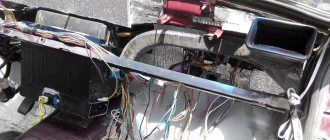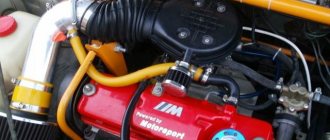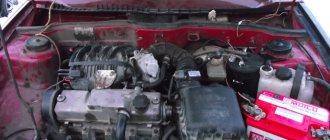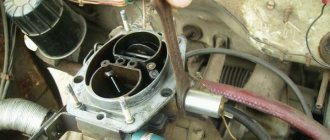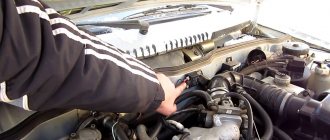Print this article Font size 16
It's no secret that the engine is the main unit of the entire car. Your ability to drive a car, consume the optimal amount of fuel, and more depends on its performance. But overheating is a very common situation in which many people make serious mistakes.
Attempting to cool the engine with water or using other similar “tricks” may not only not help reduce its temperature, but also lead to serious consequences, including the need to completely replace the power unit.
Carburetor engine
Characteristics of the VAZ 2106 engine
Engine VAZ 1.6l. Years of production. (1976, present day) Block material. cast iron. Supply system. carburetor/injector Type. string Number of cylinders. 4 valves per cylinder. 2 Piston stroke. 80 mm Bore 79 mm Compression ratio is 8.5 Engine displacement 2106. 1569 cm3 Engine power 2106. 75 hp. / 5400 rpm Torque. 116 Nm / 3000 rpm Fuel. AI92 Fuel consumption. 10.3 l in the city. | track 7.4 l. | mixed 10l/100 km Oil consumption. 700 g per 1000 km Overall dimensions of the engine 2106 (LxWxH), mm. 565x541x665 Engine weight 2106. 121 kg Engine oil 2106: 5W-30 5W-40 10W-40 15W-40 How much oil is in engine 2106: 3.75 l. When replacing, I fill in about 3.5 liters.
Service life of the VAZ 2106 engine: 1. According to the plant. 125 thousand km 2. In practice. up to 200 thousand km
TUNING Potential. 200 hp No resource loss. 80 HP
Troubleshooting Methods
Checking the functionality of the thermostat is quite easy. It is necessary to heat the engine to 90 ° C and touch the pipe that goes to the radiator. If it does not heat up, then the thermostat has failed. It is better not to repair the thermostat, but to immediately install a new one. To replace it, you need to open the cap of the expansion tank and drain water or antifreeze from the system.
Loosen and slide the clamps, and then remove the pipes. Before installing a new thermostat, you need to clear everything of the old sealant, and then apply a thin layer of new one, let it dry a little, put on and secure the pipes to the thermostat. If a breakdown occurs on the road, then you need to remove the thermostat and open the damper leading to the radiator. This action will cause the cooling system to work in a large circle all the time.
A failure of the cooling fan switch sensor is determined by the fact that the fan is not working and the radiator is all hot. Ideally, the sensor needs to be replaced, but if trouble happens on the road, then you need to short-circuit the two wires coming out of the sensor and the fan will turn on. If this does not happen, then you need to check the serviceability of the fuses.
The resulting air lock in the radiator occurs due to the difference in the density of air and coolant. It is easy to identify such a breakdown. If when the engine overheats, the radiator is not completely hot, then there is air left in the place where it would be cold. It is expelled by pressing on the upper pipe, while the plug should be open.
In case of overheating associated with a leak of antifreeze or water, it is necessary to replace the failed part. The location of the leak is determined by wet marks. If the breakdown occurs on the road and the leak is due to a defect in the pipe, it can be temporarily sealed with insulating tape. When a leak occurs through a damaged radiator or thermostat, you can get to the repair site by constantly adding the leaking fluid. It is strictly forbidden to add cold water if the engine is overheated.
Tips and tricks
In practice, most drivers, noticing an increase in temperature, strive to turn off the engine as quickly as possible. Please note that if the arrow is in the red zone, then this decision can be considered the only correct one.
However, if there is overheating, but the temperature has not reached a critical level, then it is better not to turn off the engine immediately. It is optimal to immediately reduce the speed, then stop the car and let the unit run for a couple of minutes.
The fact is that this method helps to avoid deformation and cracking of highly heated parts after they have cooled. It is also forbidden to open the expansion tank cap on a hot engine, as this may cause burns. It is also forbidden to add coolant to the tank until the engine has cooled down. The difference in temperature between heated engine parts and the liquid being poured can also cause deformation.
At the same time, it is necessary to check the functionality of the pump at each service, as well as the condition of the drive belt. In some cases, attention should be paid to the temperature sensor, which is responsible for triggering the cooling fan.
An additional recommendation is to wash the radiator and engine compartment. In this case, it is necessary to carry out all work correctly so as not to flood the electrical equipment, damage the radiator, cooling fan, etc. For older cars, it is also advisable to carry out internal cleaning of the cooling system and rinse the radiator from scale and rust.
Let us also add that if in winter the engine and engine compartment were insulated using various insulation materials, then all of these elements must be removed in order to improve cooling and reduce the load on the system.
Causes of overheating
All possible causes of overheating of the power unit of a VAZ 2109 car, as well as other cars, can be divided into two categories:
- External reasons;
- Internal reasons.
As you know, domestic nines are equipped with injectors and carburetors. Therefore, we will get acquainted with all the likely situations that can lead to overheating of one or another type of engine.
External
Let's start with the external reasons for the increase in engine temperature.
Causes Features of the situation Low coolant level Quite often the engine overheats due to the low level of coolant in the expansion tank. It is not always possible to immediately detect a leak in the system. Antifreeze requires a very small hole in order for it to completely drain out of the tank over several tens of kilometers.
The most dangerous leak is coolant entering the combustion chamber or oil, which leads to water hammer. Thermostat failure If your engine begins to overheat, pay attention to the condition of the thermostat. This unit controls the movement of coolant through a large or small circuit
If the thermostat breaks down, the coolant stops moving in a large or small circle. In the first case, the engine will have difficulty warming up to operating temperature in winter, and in the second, the engine will constantly overheat. Clogged radiator, ineffective cooling. If almost the main component of the cooling system, that is, the radiator, becomes dirty, overheating will not be avoided. If there is dirt on the radiator fins or its “honeycombs,” heat transfer is significantly reduced. Plus, pay attention to the performance of the fan. It may not work due to belt tension, a breakdown of the temperature sensor, or a failure of the fan motor. Long-term operation in unacceptable modes. Often the cause of increased engine temperature is the driver himself, who overestimates the capabilities of his car and operates it in conditions that are contraindicated for it. This is prolonged idling, improper slipping, increased speed - all these situations negatively affect the condition of the engine, since the cooling system does not have time to perform its functions. Operation of the engine in conditions of detonation. If the driver ignores the appearance of detonation in the cylinders, the engine cooling system will not be able to cope with loads. Add hot weather to this, and then you won’t envy the engine. Exhaust valve burnout If the exhaust valve fails, the gases heated to an impressive temperature will overheat the engine. The situation can only be corrected by repairing the power unit. Water pump problems If the water pump fails or stops working normally, the coolant will not be able to circulate through the system. Pump failure may be due to tension in the drive belt, defective pump blades, or breakdown of the pump itself.
Most of these faults can be determined by changes in sensor readings. On an injection engine, things are somewhat simpler, since it is equipped with a large number of sensors. Although sometimes it’s even easier to deal with a carburetor.
Internal reasons
There are several reasons that contribute to internal engine overheating.
| Causes | Peculiarities |
| Accumulation of deposits inside the combustion chamber | This is a typical problem for old VAZ 2109 carburetor and injection engines, which have driven more than 200-300 thousand kilometers. Excess oil forms in the combustion chamber. Oil burns poorly, causing plaque to accumulate on the walls. This leads to overheating, which the temperature sensor cannot report. The malfunction can be determined by the bluish smoke protruding from the exhaust pipe. Or the impaired performance of the motor will indicate this |
| Plaque in the cooling radiator | The mistake of many owners of domestic cars is that they consider it sufficient to pour plain water into the cooling system, replacing the not-so-expensive antifreeze with it. But due to contamination of the water or the use of low-quality coolant, plaque forms on the walls and tubes, preventing normal cooling of the engine. It is not uncommon that the channels are simply blocked by plaque, which leads to impaired access of coolant to them. Overheating is only a matter of time in such a situation |
| Additives in oil | We don’t know how to explain the desire to add all kinds of additives to the oil. But if you do this and don’t know why these additives are actually needed, an impressive coating will form on the cylinder walls, due to which a violation of the efficiency of the cooling system cannot be avoided |
It is not enough just to know about the probable causes of overheating of your carburetor or injector on a VAZ 2109. Be sure to familiarize yourself with the consequences, as well as your actions in a given situation.
Injection thermostat VAZ 2114 8 class: choosing the best and replacing it yourself
The reliability of any injection engine primarily depends on its design. Nevertheless, VAZ 2114 injection engines with 8 valves often suffer from non-compliance with the temperature conditions of the engine. The thermostat is exactly the device that should ensure that the engine warms up evenly and does not overheat under high loads. How to choose the right thermostat for the VAZ 2114, which one is better not to install, how to replace it, we will find out right now.
Why the thermostat does not work on the VAZ 2114: symptoms and causes
Constant overheating or, conversely, operation at a low coolant temperature not only threatens a high level of wear on rings, pistons and liners. In critical cases, overheating can cause the piston to stick or seize, rotate the main or connecting rod bearings, bend the valves, destroy the camshaft and many other unexpected troubles.
The engine of a VAZ 2108, 2109, 21099 car overheats
List of malfunctions leading to engine overheating
Low level of coolant (antifreeze, antifreeze) in the expansion tank
Add coolant to the expansion tank. On a cold engine, the level should be between the MIN and MAX marks. Check the cooling system elements for coolant leaks.
Antifreeze (antifreeze) may boil. Check their functionality - short-circuit the sensor terminals. If the fan turns on, the sensor is faulty. If not, the fan is faulty or there is a break in the electrical circuit going to it.
Thermostat is faulty
The coolant circulates only in a small circle; the thermoelement is jammed in the thermostat. Check the thermostat operation - Warm up the engine at idle speed and touch the lower radiator hose. As the engine warms up, it should gradually warm up until it is completely hot. If this does not happen, replace the faulty thermostat.
Air lock in the cooling system
The circulation of coolant in the cooling system is disrupted and the engine overheats. Air locks often occur after replacing elements of the cooling system (for example, a heater, heater tap, etc.), accompanied by draining and filling of coolant. Typically, an indirect sign of airing in the system is weak heating of the car interior by the stove, since it is the highest point of the cooling system and is most susceptible to airing.
Place the car on an inclined plane so that the nose is raised up, and the heater radiator ceases to be the highest point of the cooling system. Let the engine run in this position for 15 minutes, the air pockets will disappear. Read more.
The external part of the cooling system radiator is dirty
The radiator ceases to effectively perform its function of cooling the liquid. It is necessary to clean the outer part of the radiator with a jet of water under pressure. Or manually with a brush.
The radiator is dirty inside
Over time, accumulated deposits clog the pipes and lower radiator reservoir. We remove the radiator, pour out the dirt from it, and rinse it with water under pressure.
Incorrect ignition timing
Check that the ignition timing is set correctly and adjust it if necessary. “Checking and setting the ignition timing on the engines of VAZ 2108, 2109, 21099 cars.”
You can correct it with the octane corrector of the distributor. Rotating it back and forth.
Coolant pump (pump) is faulty
The pump impeller may be faulty (a factory defect or the consequences of poor workmanship). In this case, the circulation of coolant will be disrupted and the engine will overheat. The seal of the pump may be broken - the coolant leaks out, the engine overheats. In any case, replace the pump.
In addition, it is worth looking into the channel supplying coolant to the pump. Sometimes pieces of sealant accumulate in it, which some auto repairmen sometimes use to seal the connections of the engine cooling system. It is advisable to pick it all out from there and thereby restore its normal circulation.
It can only be eliminated by removing the cylinder head. See "Valve Carbon"
The expansion tank plug is faulty
Its exhaust valve jammed, the pressure in the system increased greatly, and the coolant began to boil. Read more: “Cap of the expansion tank of the engine cooling system of VAZ 2108, 2109, 21099”.
TWOKARBURATORS VK -More information on the topic in our VKontakte group
The basics - coolant is leaving
There are many problems with heating the VAZ 21099 engine (this is a headache for both carburetor and injection models), this is a low-quality coolant reservoir. Even if it is not operating at its maximum capacity, a breakdown often occurs and all the liquid disappears. There are very frequent cases when the container bursts at the soldering site.
Sometimes the expansion tank valve jams, which maintains high pressure in the system. If it stops releasing too much pressure, the tank may burst or the hoses may break off their fastenings. As a result, the tightness of the entire system is broken and its efficiency drops to zero.
Lada 2109 Ap-ak › Logbook › The engine will no longer overheat! Let's learn the intricacies of thermoregulation VAZ.
Hi all!
Today we will talk about the most common causes of chisel motor overheating. I will talk about my experience in repairing and operating a car, so there will be no stupid copying of text in this post. Please do not judge strictly, because... I'm not a professional auto mechanic! The main causes of overheating: 1) The most common reason is a non-working coolant fan
.
I think everyone is familiar with the principle of operation of the coolant fan - it forcibly cools the engine. It may not work for several reasons: 1.1 The coolant temperature sensor is not working. 1.2 No power to the coolant sensor 1.3 The coolant fan itself does not work
CHECKING THE TEMPERATURE SENSOR
So, if you see that the cause of engine overheating is the coolant fan not turning on, the first thing you need to do is check whether it is receiving power. Now turn on the ignition! For carburetor
On 2109 models, the coolant sensor is located on the radiator.
There are 2 wires coming to it and in order to check if there is power on them, simply short them. Don't be alarmed, it's the fan that turned on :)! If it does not turn on, then see the following points. On the injector,
the sensor is located next to the thermostat, under the air filter.
It also comes with 2 wires, but here, unlike the carburetor, you don’t need to short-circuit the wires with each other, you just need to pull out the block and the coolant fan will turn on. If after these steps the fan does not turn on, there are two reasons: No power; There is power, but the fan does not work. To finally make sure there is power, you need to ring the contacts with a multimeter or test lamp. If there is no power, then first of all we look at the fuse, and since the +
of the coolant sensor sits on the same fuse with the signal, it’s enough to just press the horn, but even the horn may not work
IT’S THE SAME FUCKING VAZ :):)
Just look at the fuse if it is intact, we follow the diagram and look at all the contacts.
If there is power, then we simply connect the fan directly to the plus
and
minus
of the battery - now it should turn on, didn’t it turn on? This means we need to replace the fan, or try to repair it :)
The engine does not warm up for a long time
With the arrival of cold weather, many car owners notice that the engine takes a very long time to warm up. Sometimes you need to drive a considerable distance in order for the temperature to at least approach the operating temperature. Why does this happen?
The temperature considered normal (operating) for different engines may differ, but on average this value is 90 degrees. If you have driven, say, ten kilometers in normal mode, and the temperature gauge does not show more than 70, then you can safely say that the engine is not warming up.
A device called a “thermostat” is responsible for the thermal balance of the engine. This is a kind of valve that switches the movement of coolant between two circuits - small and large - depending on its temperature. A large circuit runs through the main radiator, located between the headlights, where the fluid cools the most. The operating thermostat allows coolant to flow into the radiator when it reaches a certain temperature, and until that point, the fluid circulates around the radiator for faster heating.
Sooner or later, the thermostat stops working and, according to the law of meanness, its valve jams in the most “inappropriate position”: in the summer - on a small circle (the engine overheats, read why the engine on a VAZ-2106 gets hot), and in winter - on a large circle (cold fluid constantly goes through the radiator). Due to premature cooling in the radiator, antifreeze or antifreeze cannot heat up to operating temperature, which affects the general operating conditions of the engine.
An engine that is unable to reach operating temperature consumes more fuel and moving parts experience premature wear. The situation also affects the comfort in the cabin - the air coming from the heater is far from hot.
What to do? Ideally, the thermostat needs to be changed. However, if you need the car every day and there is no time for repairs, you can use two methods.
The first is to insulate the radiator. This can be done with ordinary cardboard placed between it and the radiator grille. This classic technique has been used for many decades in severe frosts, but if there are problems with the thermostat, it is not a sin to use it even at low subzero temperatures. By closing the radiator, you will block the air flow to it and reduce the cooling of the liquid - the engine temperature will increase.
The second method is to reduce the temperature of the air from the heater. The interior “stove” is essentially the same radiator, only small (read how to flush the heater radiator) and cools the engine well. By lowering the temperature on the heater control panel, you will raise it at the engine.
When driving with the thermostat not working and the radiator closed, it is important to monitor the engine temperature. The thermostat valve may “wedge” due to vibration and the device will start working. Since the main radiator is closed, the engine may not only reach operating temperature, but also overheat
Since the main radiator is closed, the engine may not only reach operating temperature, but also overheat.
But if there is severe frost outside, below -25 degrees, then, even with a working thermostat, the engine may not warm up. This is a normal phenomenon and can be corrected with the same cardboard in front of the radiator. This method was used by our great-grandfathers, and it still lives today, not only on Russian cars, but also on foreign cars.
In severe frosts, it is also important to take care of insulating the hood. You can glue its lid on the inside with noise- or heat-insulating materials or use a special insulating cape. If you're going on a long road trip and the forecast is warmer, make sure the cooling fan is working properly to avoid overheating the engine.
If you're going on a long road trip and the forecast is warmer, make sure the cooling fan is running properly to avoid overheating the engine.
And, finally, a trick that can be used to temporarily revive a jammed thermostat. If the design of the car allows, you can quietly but sharply hit the thermostat housing with the handle of a screwdriver or a wrench. Often, from such a blow, the thermostat valve breaks away from its wedge position and begins to work normally. You need to understand that such a measure is temporary and, when the engine is restarted, the valve will most likely jam again. Therefore, you need to replace the thermostat with a working one as soon as possible.
Source
Temperature sensor
Based on all of the above, we can conclude that most of the engine overheating depends on the correct operation of the machine’s cooling system. True, there are cases when the temperature sensor does not show the correct coolant temperature.
This can be checked using three resistors 600, 160, 100 ohms. This is done like this: we attach one end of the 600 Ohm resistor to the battery ground and the other to the sensor terminal.
When the ignition is turned on, the gauge needle should show about 50 degrees. Then we do the same procedure with resistors 160 and 100 Ohms. At 160 ohms there should be a reading of about 90 degrees, and at 100 about 100. If the readings are as specified, then the wiring and indicator of the sensor are working correctly and the sensor must be replaced.
Internal causes of engine overheating
The above defects in the cooling system are easily identified and corrected. They refer to external causes of engine overheating. The situation becomes more complicated when the reasons for the increase in temperature of a running motor are classified as internal failures and relate to:
- thermostat failure or abnormal functioning;
- failure in the ignition system and injection irregularities;
- sediment deposits in communications and equipment of the cooling system.
Thermostat failure leads to
that the cooling mixture circulates only in a small cycle and does not enter the radiator to lower its temperature. Checking its functional health is quite simple and effective. The engine starts and warms up to 90°C.
After this, the lower pipe leading to the radiator is carefully felt. If the thermostat valve has not opened for a long cycle, the pipe will be cold, therefore, the thermostat must be replaced. This check must be carried out first when engine overheating is detected.
You can replace the thermostat with a working one yourself in a garage. To do this, you should perform the following manipulations:
- empty the cooling system of liquid;
- loosen and move the clamps on the thermostat pipes;
- remove the pipes from the thermostat housing;
- remove remnants of used sealant;
- Install the new thermostat in its original place, securing it with sealant;
- wait for the sealant layer to dry and put the pipes on, followed by fixing them with clamps.
More serious work is required if the fuel injection mode is disrupted due to clogged injector nozzles
(see article “How to clean injector nozzles”). This happens due to low-quality fuel or abuse of all kinds of fuel additives. In this situation, it is best to go to a service station, where the injectors will be washed and cleaned of carbon deposits using special equipment.
The situation when the engine on a VAZ 2109 injector heats up can become more complicated when the coolant mixture leaks into the engine and accumulates in the sump. Such a breakdown can be diagnosed by checking the color of the oil on the dipstick.
If the oil changes its color to a more transparent one, it means antifreeze has begun to accumulate in it.
Why does the sensor fail?
- There are several contacts inside the DTOZH. Sometimes one of the conductors may become cracked, and then there is poor contact with the electronic control unit. The regulator stops transmitting readings correctly.
- If the insulation of the conductors is broken, a short circuit occurs. The temperature readings begin to fluctuate. The controller cannot process the signal.
- If the wires are broken, the fan does not start. Given the increased temperature of the liquid in the cooling system, the engine may stall.
VAZ 2115 is heating up! How he already got me. | Topic author: Zhanna
Victoria The problem is as old as time. It can be solved with several options, stingy as it is now - I change everything and try everything. The most expensive option. 1. Thermostat - check for complete operation in a saucepan. 2. Radiator temperature sensor, set to a lower temperature. 3. Change the steam-air valve, easier the cover. 4. Replace the engine temperature sensor. 5. Remove air from the system. Everything will have to be done in a complex manner.
The simplest and cheapest is to go for diagnostics, as I understand it, the auto injector, in the settings you are given a lower temperature for starting the fan in the BC, for one thing they will tell you at what temperature the fan starts now.
Liliya drain all the antifreeze and fill it with air in the system according to the instructions, most likely
Margarita antifreeze heating sensor that goes to the fan
Consequences
The consequences can be different, from fairly insignificant to such that the engine can be safely sent to a landfill.
The severity of the consequences of engine overheating directly depends on the actions of the driver himself. The sooner he takes action, the cheaper it will be to eliminate the consequences.
- If the engine runs for less than 10 minutes under extreme loads and conditions, nothing bad should happen. Domestic units are reliable enough to withstand this. In the worst case, the piston surfaces will melt slightly.
- If the engine runs in this mode for more than 20 minutes, more serious consequences should be expected. Most often, cracks form in the cylinder head, it becomes bent, the gasket burns out, the seals are damaged, the inter-ring partitions are deformed, and so on.
- If overheating is completely ignored, the consequences will be tantamount to disaster. First, the combustion chamber will fail, the engine will stop responding altogether, and the piston system will melt.
- When the oil overheats, it loses its lubricating properties, and therefore active friction of moving parts begins.
The most dangerous thing is a connecting rod breaking through the cylinder block wall. If this situation happens, your engine is finished. Look for a new one.
If the engine of a VAZ 2109 gets hot: what to do?
Situations when the engine on a VAZ 2109 gets very hot happen quite often. There are many reasons for such a dangerous malfunction, since the cooling system on VAZ cars is far from ideal.
1 - blocks with carburetor wires2 - fuel return hose3 - heater hoses4 - vacuum booster hose5 - fuel supply hose6 - clutch cable tip7 - ignition coil wire8 - radiator hoses9 - throttle rod10 - air damper rod11 - emergency oil pressure warning lamp sensor wire
The cooling system of a VAZ car is designed as follows. There are 2 circles in which the coolant (water or antifreeze) moves, small and large. While the engine is not yet fully warmed up, the liquid circulates in a small circle, but at the moment when the liquid temperature reaches 90 ° C, the thermostat is activated and a large circle opens, passing through the radiator. The following problems may occur in the operation of the engine cooling system:
- thermostat failure (breakdown);
- failure of the cooling fan switch sensor;
- airing of the cooling system;
- coolant leak;
- dirt and debris in the radiator;
- loosening of the driving fan belt;
- water pump failure.
Troubleshooting Methods
Checking the functionality of the thermostat is quite easy. It is necessary to heat the engine to 90 ° C and touch the pipe that goes to the radiator. If it does not heat up, then the thermostat has failed. It is better not to repair the thermostat, but to immediately install a new one. To replace it, you need to open the cap of the expansion tank and drain water or antifreeze from the system.
Loosen and slide the clamps, and then remove the pipes. Before installing a new thermostat, you need to clear everything of the old sealant, and then apply a thin layer of new one, let it dry a little, put on and secure the pipes to the thermostat. If a breakdown occurs on the road, then you need to remove the thermostat and open the damper leading to the radiator. This action will cause the cooling system to work in a large circle all the time.
A failure of the cooling fan switch sensor is determined by the fact that the fan is not working and the radiator is all hot. Ideally, the sensor needs to be replaced, but if trouble happens on the road, then you need to short-circuit the two wires coming out of the sensor and the fan will turn on. If this does not happen, then you need to check the serviceability of the fuses.
The resulting air lock in the radiator occurs due to the difference in the density of air and coolant. It is easy to identify such a breakdown. If when the engine overheats, the radiator is not completely hot, then there is air left in the place where it would be cold. It is expelled by pressing on the upper pipe, while the plug should be open.
In case of overheating associated with a leak of antifreeze or water, it is necessary to replace the failed part. The location of the leak is determined by wet marks. If the breakdown occurs on the road and the leak is due to a defect in the pipe, it can be temporarily sealed with insulating tape. When a leak occurs through a damaged radiator or thermostat, you can get to the repair site by constantly adding the leaking fluid. It is strictly forbidden to add cold water if the engine is overheated.
Radiator clogged
The radiator can be clogged from the outside and inside. External contamination is associated with dust and other debris, as well as insects, entering the honeycombs. This worsens heat transfer and is manifested by frequent operation of the fan and a long operating time.
Clogged engine radiator honeycomb
A good high pressure washer solves the problem. If the radiator has been in use for a long time, the car cools and heats up worse due to deformation of the honeycombs. You can “cure” this problem by replacing the radiator.
The radiator rarely clogs from the inside. This usually occurs due to poor quality antifreeze, driving on water, or as a “side effect” of radiator sealants. The presence of this problem is indicated by the coolant: it becomes cloudy, oil stains and solid particles are visible in it. Flushing the cooling system of the VAZ 2114 is carried out by completely draining the antifreeze with distilled water with the addition of radiator cleaning agents.
According to statistics, three-quarters of the answers to the question why the engine of the “four” heats up are associated with one of the malfunctions listed above. You can diagnose and eliminate them yourself without involving the services of a car service. If none of the above methods solves the problem, it is better to contact a specialist for diagnosis.
Other reasons for overheating of the VAZ-2114:
Consequences
The consequences can be different, from fairly insignificant to such that the engine can be safely sent to a landfill.
The severity of the consequences of engine overheating directly depends on the actions of the driver himself. The sooner he takes action, the cheaper it will be to eliminate the consequences.
- If the engine runs for less than 10 minutes under extreme loads and conditions, nothing bad should happen. Domestic units are reliable enough to withstand this. In the worst case, the piston surfaces will melt slightly.
- If the engine runs in this mode for more than 20 minutes, more serious consequences should be expected. Most often, cracks form in the cylinder head, it becomes bent, the gasket burns out, the seals are damaged, the inter-ring partitions are deformed, and so on.
- If overheating is completely ignored, the consequences will be tantamount to disaster. First, the combustion chamber will fail, the engine will stop responding altogether, and the piston system will melt.
- When the oil overheats, it loses its lubricating properties, and therefore active friction of moving parts begins.
The most dangerous thing is a connecting rod breaking through the cylinder block wall. If this situation happens, your engine is finished. Look for a new one.
Always check that the coolant reservoir is full
By exercising proper control over the condition of the cooling system, and carrying out all technical work on time to maintain its proper operation, the problem of overheating of the VAZ-2114 power unit will never appear, which will extend the life of the power unit.
Leaking cylinder head gasket
This problem is one of the rarest causes of engine overheating in VAZ 2114 cars. When it occurs, overheating is a secondary symptom that may be accompanied by a number of others:
In this situation, at best, the solution would be to replace the cylinder head gasket. At worst, a major overhaul of the engine with cleaning of all internal cooling channels.
When the engine gets hot, it is dangerous not in itself, but because of its consequences. Long-term driving at elevated operating temperatures first leads to loss of properties of elastic parts: valve stem seals and piston rings. Because of this, oil consumption increases, and engine operation becomes uneven and dirty. All this leads to expensive major repairs.
The consequences of severe overheating are even more severe: the cylinder head and cylinder block are deformed and sometimes crack. An engine that has survived this can no longer be repaired.
Operating temperature of the VAZ 2114 engine - is this indicator so important for the operation of VAZ 2114 systems? What could be the reason for the change in operating temperature and how to get rid of this problem? Such questions are often asked by car owners, but they do not receive clear answers. Let's try to systematize the available information.
First point: is it really so important that the operating temperature of the VAZ 2114 engine is maintained? Yes, this is really very important, as it affects many performance indicators of the car as a whole; if the temperature drops or rises, the systems stop working as usual. The normal operating temperature of the engine for the VAZ 2114 is 95-102 degrees; when it decreases, fuel consumption increases and parts wear out faster, the same thing with increasing temperature.
Dirty cooling system
The liquid can also boil if the heat exchanger is dirty. The radiator can become clogged with dirt from the outside, or maybe from the inside. The latter happens most often when using low-quality antifreeze or even plain water.
It is strictly not recommended to use water in the cooling system. Firstly, its boiling point is lower than that of antifreeze. Secondly, it starts corrosion processes inside the system. And thirdly, it does not have the lubricating effect necessary for the same pump.
In addition, by pouring plain water, the car owner runs the risk that all kinds of lime deposits can tightly clog all the channels in the engine through which fluid should circulate
And, if a carburetor is installed on the engine, then this is not so critical, but for the injector this is important, since it also has such channels
To summarize, we can conclude that the cooling system in the internal combustion engine plays a very important role and its malfunctions can lead to much more serious damage.
What to do if your car overheats in a traffic jam
When driving a car for a long time in a lower gear, the engine operates with increased power, which in itself leads to overheating. Add to this the lack of counter-flow of air necessary to cool the radiator. What to do? The main thing is not to panic. Short-term overheating is not terrible, but if you see that the car is not cooling down, it’s time to act.
Important - do not turn off the engine unless absolutely necessary. Exactly - without extreme
A stalled, overheated engine is an almost 100% guarantee of repair. It will take quite a long time to describe what is happening in the engine in this case (rotating the liners together with the crankshaft, when the engine is subsequently started - the least of the possible troubles), just take it on faith.
Important - do not think about pouring water on the engine or pouring cold water into the radiator. The result is the same - repair. Moreover, you can try so hard that you cannot do without replacing the block and cylinder head. Another “beauty” of cold water is microcracks inside the block. Finding and eliminating will be very, very difficult, if not impossible. The car has overheated - try to pull over to the side of the road. If it doesn’t work out, don’t panic and don’t pay attention to those around you – it’s important for you to save the engine. Stop at idle, turn the heater on full, and wait. If after 5-10 minutes the situation does not improve, turn off the engine. It’s a good idea to open the hood; the main thing in a panic is not to forget to set the car’s parking brake. The only reason to turn off the engine right away is clouds of steam coming from under the hood. Most likely, the cooling pipe has burst, and further operation of the engine will only worsen the situation.
This is what it looks like, engine overheating, if you look closely. Now you know why the engine gets hot and how to deal with it.
Didn't find the information you are looking for? on our forum.

